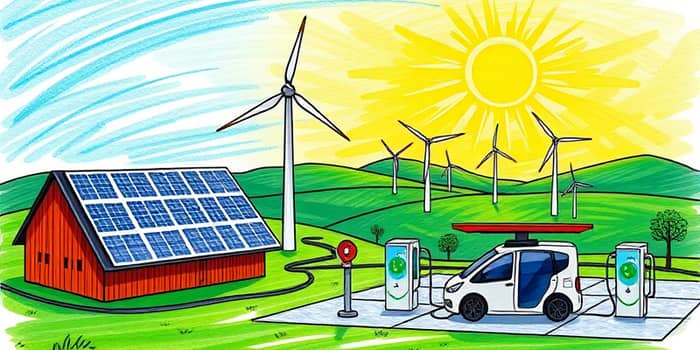As the world pivots toward sustainable solutions, investors are presented with unprecedented opportunities. This article explores the transformative potential of green technology, offering insights, data, and strategies to navigate a rapidly evolving market.
Market Growth Projections and Potential
The green technology and sustainability sector is poised for explosive expansion over the next decade. Recent analyses forecast growth from $25.47 billion in 2025 to $73.90 billion by 2030, reflecting a robust compound annual growth rate (CAGR) of 23.7%. This trajectory underscores the vast investment potential and the urgency of reallocating capital toward clean solutions.
Global investments in green technology reached an impressive $1.77 trillion in 2023, marking a 17% increase year-on-year. Yet, this sum represents only one-third of the funding required to achieve net-zero carbon emissions by 2050. Bridging this gap demands strategic investments, innovative financing models, and sustained policy support.
Clean energy technology investments are set to eclipse upstream oil and gas spending in 2025 for the first time in history. With projected cleantech energy supply spending of $670 billion, areas such as renewable power generation, green hydrogen, and carbon capture and storage (CCS) are at the forefront.
Breaking Down Recent Investment Trends
Investment momentum in clean energy and transportation continues to accelerate, especially in the United States. In Q1 2025, total spending reached $67.3 billion, a 6.9% increase compared to Q1 2024. Over the past year, U.S. investments in clean energy, clean vehicles, building electrification, and carbon management climbed to a cumulative $277 billion, up 13% year-on-year.
The electric vehicle sector stands out as a key driver. Since the enactment of the Inflation Reduction Act (IRA), quarterly clean manufacturing investments have surged from $2.5 billion in Q3 2022 to $14.0 billion in Q1 2025. The electric vehicle supply chain now anchors a significant share of this growth, from battery production to assembly lines and charging infrastructure.
Key Sectors Driving Innovation
Several core areas are shaping the green technology landscape. Understanding their dynamics helps investors allocate resources effectively.
- Renewable Energy Expansion: Solar and wind power dominate, with $41.3 billion in new utility projects announced in Q1 2025. Solar PV alone is set to capture half of all cleantech investment, including distributed behind-the-meter installations.
- Electric Vehicles and Charging Infrastructure: The transition to electric mobility fuels demand across the entire supply chain—from lithium-ion batteries to power electronics and fast-charging networks.
- Energy Storage Systems: Battery energy storage systems (BESS) will surpass pumped hydro in capacity, supporting grid stability and integrating variable renewable sources.
- Industrial Decarbonization: Investments in hydrogen production, sustainable aviation fuel, and carbon management technologies are critical for heavy industries seeking net-zero pathways.
- Climate-focused Software Solutions: AI-driven energy management, carbon footprint tracking, and blockchain-based reporting tools optimize operations and ensure regulatory compliance.
Drivers and Challenges Shaping Investments
Understanding the forces propelling and restraining the green technology market is essential for informed decision-making.
- Key Drivers:
- Technological breakthroughs in AI-driven energy management software accelerate efficiency gains.
- Government incentives like the Section 45X Advanced Manufacturing Production Tax Credit bolster manufacturing investments.
- Corporate sustainability commitments and consumer demand propel ESG adoption across industries.
- Regulatory mandates on carbon reporting and emissions reductions create market certainty.
- Major Challenges:
- Integration of diverse sustainability solutions across legacy IT systems remains costly and complex.
- Geopolitical tensions, tariff escalations, and macroeconomic pressures can disrupt supply chains and financing.
- Project cancellations peaked in Q1 2025, with six projects totaling $6.9 billion called off, signaling execution risks.
- Current investment levels fall short of requirements for tripling renewable capacity by 2030, highlighting a funding gap.
Investment Approaches and Opportunities
Investors can engage with green technology through multiple channels. Aligning capital with sustainable impact requires both patience and strategic foresight.
- Direct project investment in wind farms, solar arrays, and BESS installations.
- Equity stakes in cleantech startups focusing on innovations such as green hydrogen, circular materials, and precision agriculture.
- Debt financing for large-scale infrastructure projects, benefiting from government-backed guarantees and tax incentives.
- Green bonds and sustainability-linked loans that tie returns to environmental performance metrics.
Beyond financial vehicles, investors can influence broader ecosystem growth by supporting policy advocacy, industry collaborations, and research initiatives that address technical and regulatory bottlenecks.
Global Shifts and Regional Insights
The green technology market reflects a global realignment. Regions with rapidly growing power demand—such as Asia-Pacific and parts of Latin America—are investing heavily in distributed energy systems and storage solutions.
Meanwhile, manufacturing is relocating to areas offering favorable policy frameworks and cost efficiencies. Since August 2022, over 380 clean technology manufacturing facilities have been announced in the U.S., nearly half of which are already operational. This shift illustrates the critical role of supportive legislation and incentives in attracting capital.
Crafting a Sustainable Portfolio
To build a resilient, impact-driven investment portfolio, consider these guiding principles:
Diversify across technologies to mitigate sector-specific risks and capture growth in renewable energy, transport, storage, and software.
Prioritize scalability and innovation by backing companies with strong R&D pipelines, solid balance sheets, and clear pathways to commercialization.
Engage in active stewardship through shareholder advocacy, collaboration with management teams, and participation in industry consortia.
Monitor policy developments at national and international levels to anticipate shifts in incentives, regulations, and market access.
Conclusion: Seizing the Moment
Investing in green technology is more than a financial decision—it is a commitment to shaping a sustainable future. With transformative innovations on the horizon, investors have the opportunity to generate meaningful returns while driving positive environmental and social outcomes.
By understanding market dynamics, embracing diverse investment approaches, and fostering collaboration across sectors, stakeholders can bridge the funding gap and accelerate the transition to a low-carbon economy.
The journey toward a cleaner planet is already underway. Now is the time to align capital with the principles of sustainability, unlocking both profit and purpose in the new green economy.
References
- https://www.globenewswire.com/news-release/2025/03/20/3046392/28124/en/Green-Technology-Sustainability-Market-Report-2025-Global-Green-Tech-Market-to-Skyrocket-to-73-9-Billion-by-2030-Driven-by-AI-ESG-Compliance.html
- https://www.cleaninvestmentmonitor.org
- https://www.cleaninvestmentmonitor.org/reports/q1-2025-update
- https://rmi.org/trillion-dollar-win-clean-energy-investment-benefits-growth-and-jobs-in-all-states/
- https://www.investopedia.com/articles/investing/040915/investing-green-technologythe-future-now.asp
- https://rhg.com/research/clean-investment-monitor-us-clean-energy-supply-chains/
- https://www.investopedia.com/terms/g/green_tech.asp










